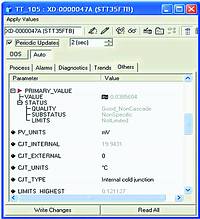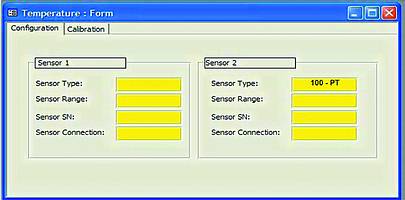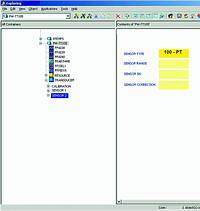
When IEC 61804-2 Electronic Device Description Language (EDDL) was approved as an international standard in March 2004, the EDD source files created using EDDL were already deployed in millions of process industry field devices.
EDDL is a text-based language for describing the digital communication characteristics of intelligent field instrumentation and equipment parameters - device status, diagnostic data, and configuration details - in an operating system (OS) and human machine interface (HMI) neutral environment.
Initially developed in 1992 for use as part of the HART Communication Protocol (HART, www.hartcomm.org), EDDL based-technologies continue to evolve. EDDL is being enhanced to extend the concept of interoperability to the HMI and diagnostic data.
Today, EDDL technologies form the engineering and operating foundation on which all major digital fieldbus protocols - Foundation, HART, and Profibus - construct parametric and device descriptions. And, because EDDL is an open technology with international standard status, it can be easily and effectively applied to any device and any fieldbus protocol.
The EDDL technology enables a host system manufacturer to create a single engineering environment that can support any device, from any supplier, using any communications protocol, without the need for custom software drivers for each device type.
Matching needs
Technologies and standards appear and disappear all the time. Often, those who buy into the 'technology de jour' have later been disappointed and incurred unnecessary expense to replace a 'promising' but unsupported technology.
Today's process industry users have become very cautious about buying 'technology hype,' especially when faced with choosing a technology that must remain in place for a decade or more.
When discussing digital field automation technology architectures, users state their concerns a hundred different ways, but in the end, what users seek are assurances the technology platform they choose provides:
* Freedom of choice in plant floor instrumentation and equipment independent of the host - valves, transmitters, motor starters, remote I/O, etc.
* Consistency in how plant floor instrumentation and equipment is engineered.
* Flexibility and efficiency in how plant-floor data is shared throughout the enterprise.
* Ease of maintenance.
* Quantified proof that adopting manufacturers have long-term commitments to expand and improve the underlying technology.
A seldom mentioned, yet important realisation influencing a technology's success is its dependence on other technologies. From a product manufacturer's perspective, the less dependent a technology's architecture is on underlying technologies, the better. Not only does such a design help manage risk, it frees-up development resources to enhance and improve product features - something end-users seek when evaluating similar products from different manufacturers.
Overall, the simple elegance, enhanced capabilities, and OS and HMI neutrality of EDDL technology provides solutions that address the engineering and operating questions, concerns, and needs of both end-users and manufacturers.
Empowering users
Frequently, marketing literature and sales presentations state that end-users insist on a single engineering environment to manage, commission, and configure any field device, from any manufacturer, to any fieldbus protocol.
Similarly, the engineering environment is often the focus at industry and user group meetings in the form of a multipart question, "During a process automation system's (PAS) life-time, what percentage of time will/did it take to:
1. Develop the initial database and control logic?
2. Perform software maintenance and upgrades?
3. Make periodic engineering improvements and enhancements?
Undoubtedly engineering, configuring, and managing activities are important. Further, when those activities are compared to the amount of time operators use the system, experienced users also ask, "How consistent can we make our HMI systems so our operators can confidently and efficiently use them?"
Depending on the data source, it is usually agreed that operations personnel use the PAS 70 to 85% of the time, with other activities sharing the remaining 15 to 30%
While engineering, installation, development, and improvement activities are fundamental, it is equally important to understand how EDDL technology is being enhanced to meet the daily needs of operators and maintenance personnel.
Operator information and interaction
EDDL technology creates source files containing only content relevant to a specific manufacturer's intelligent field instrument or device. This is an important aspect of the EDDL technology design philosophy that insists that EDD files remain OS and HMI neutral.
For manufacturers of intelligent field instrumentation and equipment, this philosophy eliminates the need to expend resources designing and writing software to support operator interfaces - specifying fonts, sizing windows, selecting colours, etc - for different manufacturers HMI products and platforms.
For end-users, EDDL's neutrality philosophy ensures that operators are provided information with a look and feel that is consistent with other information being presented on the same HMI.
Some might argue that content is more important than consistency; this may be correct for operating information that users access several times an hour. However, EDD file content provides access to 'normal' and 'abnormal' operating information. EDD file content is about access to information contained in intelligent field devices and equipment, the sort of information that is viewed by operators during all sorts of process operations.
Because abnormal process operations occur infrequently - every few days, weeks, or months - presentation consistency does become important. For example, most of us have experienced the 'use it or lose it' software phenomenon; the one where we revisit a software application we once knew well, only to find we have forgotten a lot of what we once knew.
That is exactly what EDDL's design philosophy avoids. Most people would agree that when faced with efficiently evaluating and acting on information, a familiar presentation format provides users with considerable confidence that they are making the correct decisions.
There is no doubt that a technology for deploying digital field instrumentation or equipment should provide efficiencies in addressing the development of the initial database and logic, aid maintenance, and support enhancements. As previously noted, those functions are employed about 15 to 30% of the time.
Most of the time the efficiency and effectiveness of the technology is being 'realised' by process operators and maintenance technicians, thus the technology must do-its-work in a way that makes these individuals comfortable.
Using a Foundation Fieldbus-based temperature transmitter as an example, Figure 1 shows the parameters as they would appear on an HMI, if read directly from the EDD without any parametric organisation applied.

Figure 2 shows how those same parameters could be organised on the HMI by using the EDDL enhancements. In this case, the host system supplier has chosen to use dialog boxes with identifying Tabs.

Figure 3 shows an alternate display organisation of the parameters using the exact same EDD. In this case, an 'explorer view' of the temperature transmitter contents is shown. The enhancements to EDDL provide the host system manufacturer with the flexibility to organise the parameters of a field device in the manner recommended by its manufacturer, but consistent with the look and feel of the HMI.

EDDL technology is designed to address engineering, start-up and daily operations requirements, with special emphasis on ensuring that operators and maintenance technicians are comfortable using the technology to make critical operational decisions.
Addressing engineering requirements
EDDL technology addresses the engineering requirements of end-users and intelligent field device and equipment manufacturers. Though their reasons differ, the engineering requirements of both groups are similar, each seeking solutions that:
* Ensure operating system independency.
* Support multiple fieldbus protocols.
* Avoid special, proprietary, or executable files for different host system platforms.
* Support multiple country codes and international languages.
* Utilise standardised testing and validation procedures and tools.
* Efficient configuration entry.
* Uses a robust, consistent, easy to identify revision control methodology.
* Includes third-party testing and registration.
Besides meeting all of these engineering requirements, EDDL technology also has international standards status as IEC 61804-2. EDDL's design philosophy provides end-users and intelligent field device product manufacturers a consistent and rich engineering environment.
Maintenance and upgrades
When control and automation systems adopted 'open system' technologies, software maintenance, with mandatory and voluntary software upgrades, increased dramatically. Today it is not uncommon to install mandatory software upgrades and/or OS security patches two or more times a month. However, EDDL's neutrality to OS and HMI technologies eliminate the need for end-users to worry about what happens to EDD files as a result of software upgrades.
Everyone who has upgraded a computer from Microsoft Windows 98 to Windows 2000 and later to Windows XP appreciates the complexities of re-linking applications, re-loading device drivers, re-establishing network communications, and dealing with incompatible executable files. EDDL technology does not install or create any executable files in the HMI host application; thus EDDL-based technologies eliminate the need to re-link applications or communications, and incompatible EDD files simply do not exist.
One feature personal computer users have come to appreciate is the 'plug-and-play' technology known as Universal Serial Bus (USB).
From a user's perspective, USB appears quite simple and regardless of the device manufacturer or device type that has been plugged-in, what appears on the user's screen is consistent for Windows users and different, yet consistent for Macintosh users.
Behind the scenes USB shares a lot of similarities with EDDL technology. Both use device description files and both make use of device descriptor services embedded in the host platform that are designed to provide users with a consistent information presentation format.
Similar to the efforts that produced USB, representatives of Fieldbus Foundation (FF) www.fieldbus.org, HART Communication Foundation (HCF) www.hartcomm.org, and Profibus Nutzerorganisation e.V. (PNO) www.profibus.com met in February 2003 to extend the capabilities of the IEC 61804-2, Electronic Device Description Language standard.
Among EDDL's extensions are improved device data organisation, graphical visualisation consistency, and support for persistent data storage.
The objective is to specify a common set of enhancements, validate and then incorporate the enhancements into the EDDL technologies of the respective Fieldbus organisations. Later, when the IEC 61804-2 standard undergoes its required review and maintenance, the enhancements will be added to the International Standard.
From a system administrator's perspective, the simplicity, longevity, robustness, and OS and HMI platform neutrality of field devices conforming to IEC 61804-2 simplifies software maintenance activities. For already overworked control system engineers/technicians, eliminating software maintenance worries is a welcome benefit of deploying EDDL-based Fieldbus technologies.
For intelligent field device manufacturers, knowing that EDD files are always OS and HMI neutral permits each manufacturer to release a new product when the product is ready and not have to wait until the product completes compatibility testing with a variety of different HMI manufacturers and/or OS revisions.
| Tel: | +27 11 249 6700 |
| Email: | [email protected] |
| www: | www.acs-autocon.com |
| Articles: | More information and articles about Automation Control Solutions |

© Technews Publishing (Pty) Ltd | All Rights Reserved